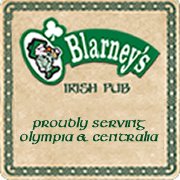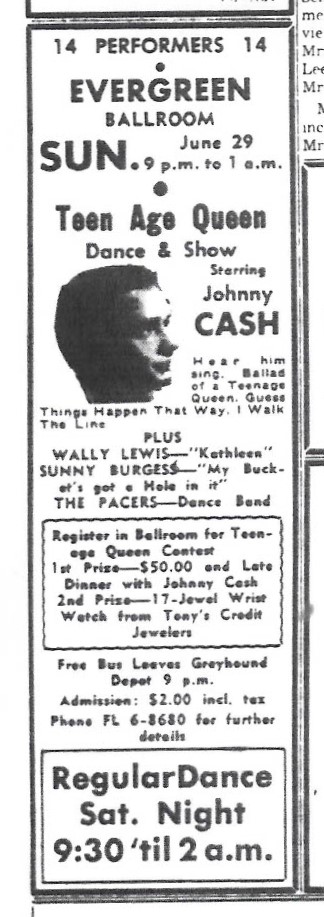At midnight on June 29, 1958, KGY radio listeners in Lacey, Olympia, and the entire radio wave receiving area, tuned in to hear the latest recording from the Evergreen Ballroom on Pacific Highway just outside of Lacey. Johnny Cash was the headliner that night taking the stage and wowing the crowds. The Green, as it was informally known, was the hot spot for hitting the floor with a dance partner and watching bands perform. Gas was about $.28 a gallon, but you could hop the Greyhound bus for a ride out to all the fun.
 The Evergreen Ballroom was a dance hall and concert venue played by a long list of notable musicians, and it was truly a legendary piece of Pacific Northwest rock and roll history. Throughout the 1930s, 1940s and the 1950s, talent such as Louis Armstrong, Duke Ellington, The Andrew Sisters, Hank Williams and Buck Owens belted out tunes. Even the singing and dancing duo Fred Astaire and Ginger Rogers twirled across the floor.
The Evergreen Ballroom was a dance hall and concert venue played by a long list of notable musicians, and it was truly a legendary piece of Pacific Northwest rock and roll history. Throughout the 1930s, 1940s and the 1950s, talent such as Louis Armstrong, Duke Ellington, The Andrew Sisters, Hank Williams and Buck Owens belted out tunes. Even the singing and dancing duo Fred Astaire and Ginger Rogers twirled across the floor.
“The Evergreen Ballroom booked some of the top Black performing groups in the country, exposing local residents to different types of Black culture,” says Ken Balsley who serves on the Thurston County Historical Commission. “It also attracted Black soldiers from Fort Lewis. In that respect, no activity or organization had such an impact on the diversity of Thurston County than did Evergreen.” Balsley, also a prior concert patron at the ballroom, connects to it with additional sentiment as it is where he proposed to his wife one New Year’s Eve.

Photo courtesy: Washington State Library / The Daily Olympian
When Cash arrived to play the ballroom, he was just eight years out of high school and two years out from playing The Grand Ole Opry. Cash’s new song, “Ballad of a Teenage Queen,” debuted January 6, 1958. The ballad is a dreamy love story of two young people, separated but then reunited. He was the boy next door who worked at the candy store. She was star struck and got whisked off to Hollywood only to throw it all away and run back to him in the end.
With a new song, promoters and performers want it to be heard, talked about and to have fans calling the radio stations to play it. In preparation for the concert and in mind of the new song’s title, the ballroom promoted a Teen Age Queen Dance and Show. The Daily Olympian announced, on the Thursday prior to Cash’s performance, that Irv Sholund was staging the competition. Contestants registered at the Sunday-night event and were judged throughout the night. The first prize winner received $50 and dinner with Cash. Someone snapped a picture, and he kissed her. The winner later went home to call her friends and told them all to listen to KGY at midnight to hear the live recording.
“I think teenagers and those in their early 20s appreciated that one of their own (me) was interviewing groups they were listening to on KGY,” says Steve Bean, Olympia area attorney and former KGY radio employee. His task that summer night was to interview Cash, record the music and play it on air at midnight. Along with a couple of friends to manage equipment, Bean and crew recorded on reel to reel recording equipment along with sturdy, heavy microphones. Bean continues saying that the station played “The Champs’ ‘Tequila,’ The Coasters and, of course, Johnny Cash and the girls loved the Teenage Queen contest. Many parents wouldn’t let their kids go there…booze and soldiers on one side and a restaurant on the other. The most memorable things about Johnny Cash were his charisma, his all-black look and his taking his time before answering questions, something Joaquin Phoenix absolutely nailed in the movie ‘Walk the Line.’”
The Evergreen Ballroom had a long history of being a popular venue for bands along the route between Seattle and Portland. Originally built in 1931 by Walter Sholund, who had come to Olympia after a career in carpentry, the dancehall was to be a new direction for Sholund and his wife Mary. The building was constructed out of old growth timbers, styled after a barn and was without electricity. So many roadhouses were lit with gas lamps that they earned the name Kerosene Circuit in relation to performers making their way along from one to the next. The Sholund dancehall boasted a restaurant and, eventually, a 1,670-square-foot dance floor. Sholund and his family were not just business owners but were also the in-house band. Sholund was a violinist, and it was a family affair with his sons playing the trumpet, saxophone, clarinet and drums. It was the dance hall that brought the people, and it was the dancing people that brought the bands.

Lacey’s landmark music venue may get its historic recognition.
“The Thurston County Historical Commission is working closely with the City of Lacey in establishing a site for the construction of the monument,” shared Balsley. “Our first choice is the Regional Athletic Complex, which was a joint project of Thurston county and the City of Lacey. It is also less than half a mile from the site of the ballroom.”
The community thoroughly enjoyed the Evergreen Ballroom and experiencing the many, many performers who came through over the decades. The ballroom burned down in July 2000, and the community has not had another like it.

















































